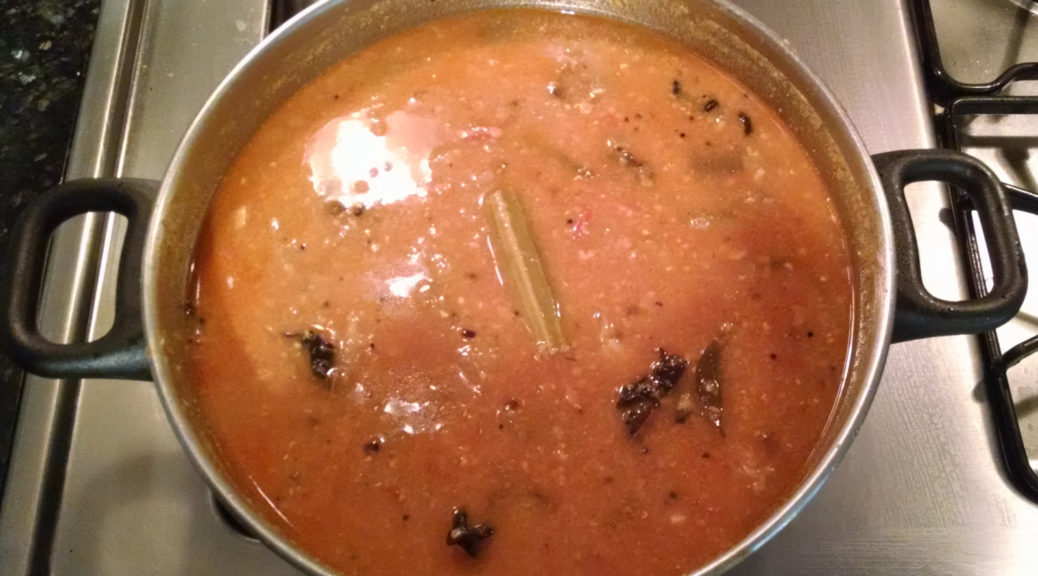Last Updated on 2016-12-25
Sambar Recipe (सांबर)
Turned out great. Quantity overshot a lot, did not need that much!
Probably cooked around 16 cups (4 quarts in a 5-qt pot), needed only around 6-10 cups of sambar.
This was very easy to cook using prepared sambar powder. Only thing is that it needs a number of ingredients.
Sambar is great in that one can add any vegetables. For me, drumsticks are a must. For fun and because I like the texture, I also added Woodear mushrooms from the local Korean shop!
Serve sambar with rice or dosa or idli.
The tricky thing here is how much hot red chilli to add. Chillies or chilli powder can’t be added as salt can, it requires cooking, so difficult to adjust it while cooking. I added 4 chillies, 1/2 teaspoon red chilli powder, along with the 2 tablespoons of sambar powder (which also has the chilli spices), and it turned out a bit on the hot/spicy side. So for the recipe below, I removed the 1/2 teaspoon chilli powder, though if you like things hot, feel free to add it.
Time: 60-90 minutes
Serves: 10-16 (makes around 4 quarts or 16 cups)
Toor dal – 1/3 cup
Masoor dal – 1/3 cup
Wash dals, soak in cold water for around 30 minutes.
Then add 3-5 cups water as needed, boil it, lower to simmer and cook until they almost dissolve. No need to mash it, just fine with boiling. Takes around 30-40 minutes.
Tamarind – soak 1-2 tablespoons in 3/4 cup warm water for 30 minutes then filter it out to get tamarind juice. Or use 1 tablespoon tamarind paste and add it while cooking.
In parallel, cook the sambar. Some recipes call for just boiling all the vegetables with the spices, while some saute vegetables and then proceed to boiling. I prefer the latter, though I’m told it probably makes no difference in the final taste.
Mustard seeds – 1 teaspoon
Cumin Seeds – 2 teaspoons
Curry Leaves (kadi patta) – 10-12
Dry red whole chillies – 3-5
Oil – 2-4 tablespoons
Onion (1 large – 1-1.5 cups), chopped into around 1 inch squares, or any way you wish, just keep the pieces large or long.
Asafoetida (hing – 1/4 teaspoon)
Urad dal (white, husked, 1 teaspoon)
Fenugreek seeds (1 teaspoon)
Cumin powder (1 teaspoon, optional)
Coriander powder (1 teaspoon, optional)
Add oil to a pot, covering the bottom of the pan.
Add red chillies and mustard seeds. When seeds start to pop, add the cumin seeds, curry leaves, urad dal, fenugreek seeds. The urad dal will turn a bit darker in a few seconds, add asafoetida, coriander powder, cumin powder, stir a few times, then add the onions.
Cook the onions for 2-4 minutes, until they become a bit soft.
Sambar powder – 2 tablespoons (I used MTR Brand)
Drumsticks – handful (1-1.5 cups)
Got the frozen variety, only one available in most parts of the US, I bet. Cut into 3 inch/finger length pieces if not already sliced. Thaw them for cooking (run them through cool tap water for quicker thawing).
Eggplant (1-2 small – 1-1.5 cups when cut into cubes)
US grocery stores have humongous eggplants, only used a quarter of one large eggplant for this.
Okra – (0.5 pounds, around 1-1.5 cups).
Cut into 1-2 inch pieces. Cut and discard small sections at the top and bottom of each okra.
Woodear mushroom (7-9 pieces, optional – any vegetables you want can be added to sambar!)
Salt to taste
Add all the other vegetables you want with the sambar powder and cook for 5-7 minutes.
Important to add salt along with the vegetables. 1-2 teaspoon at this time, and then later can add more to taste.
Tomatoes (1 large or 2-3 small, around 1-1.5 cups)
Jaggery (gur) – 1-2 tablespoon
Add tomatoes, tamarind juice and jaggery and cook for 5-7 minutes more.
Then add 1-2 cups of water, bring to boil, and then cover pot and cook on low heat for 15-20 minutes. After this, vegetables should be soft and nearly cooked.
Then add the cooked dals and sufficient amount of water to get the consistency you want. Add more salt and jaggery as needed at this point too.
Cook on low heat for another 10-20 minutes, and it is done.
Sprinkle chopped green cilantro on top, and it is now ready to serve.
Sambar tastes good even after refrigerating it and cooking it on day two and day three and so on. Vegetables taste more flavorful after soaking in the sambar spices.

